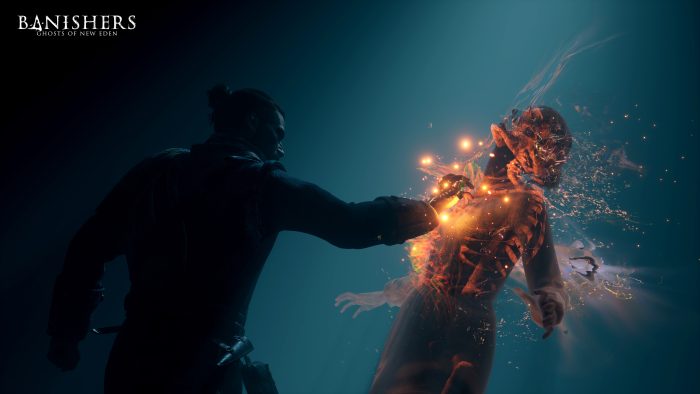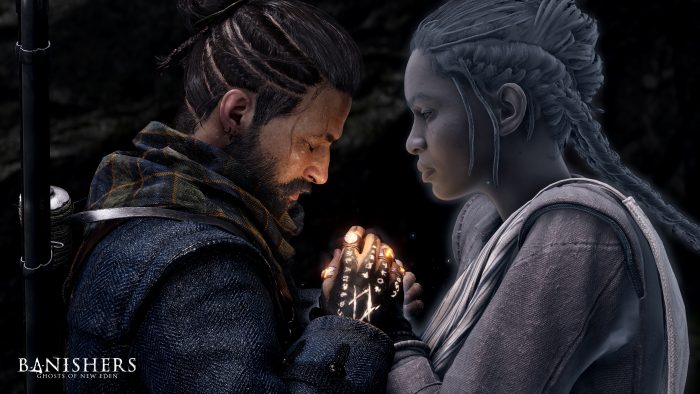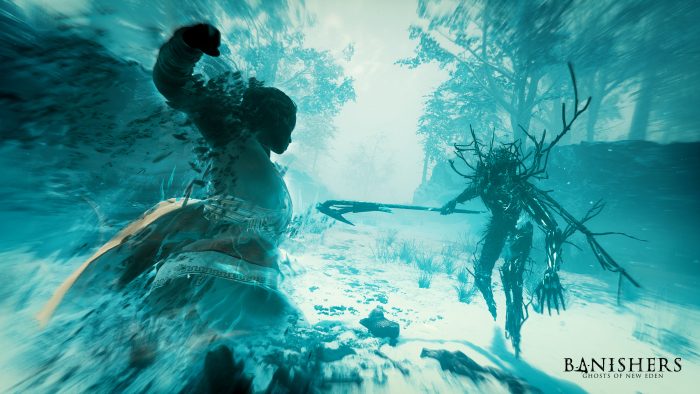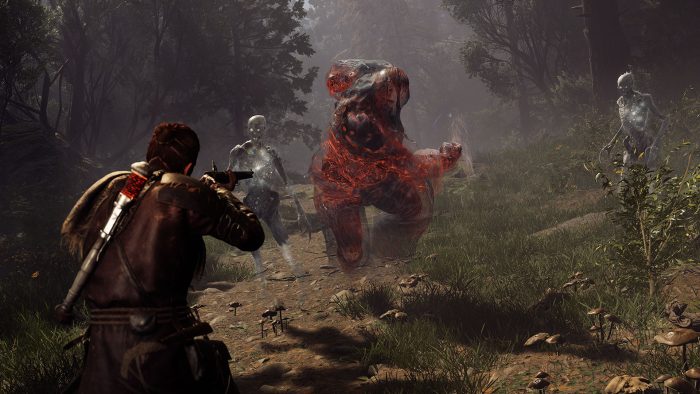An enthralling mystical epic that has a few rough edges to the magic
Don’t Nod first came onto the scene in 2013 with their compelling albeit flawed action game Remember Me, breathing new life into the amnesiac character trope by incorporating unique gameplay features. Since then they’ve focused on delivering interesting mechanics that go hand in hand with thoughtful narratives and their themes. Now, over a decade later, they’ve returned with their most ambitious project yet, the action roleplaying game Banishers: Ghosts of New Eden.
In it we take control of Antea Duarte and Red mac Raith, mercenaries known as Banishers who deal exclusively in the supernatural. After receiving a letter from their trusted friend detailing a powerful ghost cursing the town of New Eden the two set sail for North America. The love on display between Antae and Red is easily the best love story I’ve experienced in a game, and it’s used to great effect to juxtapose the bigotry among many living in the late 17th century, when Banishers takes place. It’s a game that explores concepts like empathy and inclusivity, in a time and place where such ideals were in short supply.

The entire introductory act should be a masterclass on the process of onboarding a player to the tenets of a game, both in terms of its mechanics and the emotions it wants to express in its storytelling. The game begins with the Banisher’s boat coming to a rest on the shores of Massachusetts Bay, near New Eden. On the hike into town simple spectral enemies and environmental objects are placed in our way to teach us the ropes of exploration and combat. The tutorial ends when everything goes sideways when the powerful ghost haunting the town defeats us; Antea is killed and turned into a ghost, while Red is thrown into the ocean, swept many miles away. Even death will not stop them from accomplishing their mission, so they began the long journey back to New Eden to banish the spectral nightmare. But first they need to decide what to do about Antea once the hauntings are resolved: ascend her spirit to a higher plane or resurrect by draining the life essences of the majority of the NPCs in the game.
Banishers is an absolute beast of a game, with a massive map consisting of many giant regions. On the journey back we’ll come across three major settlements consisting of those that evacuated New Eden after our apparent demise. Each of the three encampments and their surrounding environments are large and diverse, each acting as a chapter within the game. It feels like every subregion has a chest requiring three hidden keys to find, a treasure map to a secret cache of loot, materials to farm and collect, and special repeatable combat zones to increase stats and farm even more materials. It’s quite literally the case that everyone (and there are many) in the game will be haunted by a ghost at one point or another and it’s our job to decide how to help.
In Banishers sidequests take the form of Haunting Cases. When an individual is haunted by a ghost their life is slowly drained from their body. Many are unaware of the cause, not being able to see into the spirit world; only a few are ever aware of Antea’s spectral form. Cases boil down to the rudimentary detective game where evidence reveals footprints or reenactments, and after gathering enough clues one can guess at what happened. It’s a simple formula but it’s done well here because they feel relevant to the player because they are all tied into Banishers’ central theme of bringing Antea back to life or letting her go. At the end of each case we have to decide to get rid of the ghost or kill the one being haunted, letting Antea feed on them, for it’s only by killing the majority of the people can she be brought back to life. The path we choose determines how people interact with us, but also how we interact with each other. It also is the primary way of earning skill points, or in regards to the main cases, unlock specific abilities for Antea. However, while this mechanic feels relevant to the story and gameplay progression, the choices we have to make at the end do not because both of their personalities are a far cry from that of a murderer. What should be compelling player agency is lost to the fact that Red would only kill a fly if it were already a ghost.

While the core tenant of the haunting case is flawed, it’s still interesting. Interesting but flawed is a theme that carries over to combat as well. Similar in design to the recent God of War titles, Banishers is a single player action-adventure that has us using the abilities of two primary characters at once. Unlike God of War, however, we find ourselves switching between Red and Antea, controlling one on the screen at a time. Each character has various stats (from skills and gear) that determine their offensive and defensive efficacy in battle, but there’s also other variables that determine who we are better suited to use at any given time. Possessed wolves and human corpses are weaker to Antea’s spiritual punches, while others might be weaker to Red’s blade and rifle attacks. The concept of parrying is executed well with the game’s theme fighting synergistically together, as by switching to Antea after specific conditions are meant (such as right after a block or during a forward evade) will result in a special attack. Controlling Red during a situation that would better suit Antea, she’ll remind us (even when she’s wrong) to high heaven so much that heaven quickly begins to feel like hell. There were times she would repeat the same warning several times in the span of ten seconds.
I am compelled to note the boss encounters are all very well done. Every fight is unlike the rest, with some cool gimmicks to differentiate them. And the developers thought hard on how to incorporate them into the narrative and lore in fascinating ways. An early boss was an amalgamation of many corpses previously wronged, and it implied the Biblical demon known as Legion was the same type of creature. The only negative I can lay at them is that like the rest of the game, they aren’t all that difficult. After defeating the boss at the end of a chapter’s main haunting case Antea will unlock a new ability, and unlike most Metroidvanias, every ability has important uses in both exploration settings and combat scenarios. For every impossible gap we leap over with spiritual teleportation there’ll be an opportunity for leaping into an enemy; for every group of enemy we can decimate with an area-of-effect spiritual explosion there’ll be a rock wall to break down as well. The skill tree is very simple to understand, but offers a surprising amount of depth to modify our playstyle. At the center of the tree is the ability unlocked, which branches out to different groups. Each group has four skills divided in two tiers, which forces us to think best on how to proceed. If one is confident in their skill they can increase a character’s offensive stat by sacrificing defense, or vice versa. And if we make a mistake we can always respec at a campfire, which is where we can rest and fast travel, refill consumables, as well as upgrade gear.

Unfortunately, combat becomes boring and stale after a while because there’s never any real sense of challenge and enemy variation is severely limited. It didn’t take long before I figured out a playstyle that broke the game and carried me all the way through to the end. In combat we’re able to fill up a Banish gauge by dealing damage, and once full unleash a more powerful attack. There are various modifications we can make in the skill tree that cause the damage input of one of Antea’s abilities to be increased significantly when the gauge is full, before draining it; and because of an ability where every rifle shot from Red nets him Banish points, even the most powerful enemy becomes a cakewalk. And there’s only a handful of enemy types we’ll be encountering on this journey besides, and just because they come in elite and alpha versions on occasion won’t make that any less true.
Combat, and the overall game itself were further hindered by a bevy of technical issues. During combat it wasn’t uncommon for the character to do a sudden 180 degrees. I can’t be sure of the reasoning for it, or if there’s a secret mechanic, because there is a quick turn button on the d-pad that I never used. Getting caught on the environment and enemies was another common annoyance. Outside of battle there are environmental obstacles like ledges we can climb over or sidle across through context sensitive button presses, but if we enter into combat this is impossible. After going through an area for the fourth or fifth time and being forced to fight isn’t exactly a good time. These are relatively minor issues compared to the worst I came across, though.

My 80 hours with the game would’ve been more like 60 if it weren’t for three softlocks and an entire chapter worth of an area that wanted to run between 0-10 frames a second. The first softlock caused me to lose two hours of playtime. By the third and final one I decided to wait for a patch, and thankfully when that hit my issue was fixed, as well the stuttering of the area. But much of my experience with the game had been tarnished by then.
If someone had asked if I recommend Banishers: Ghosts of New Eden when I was in the midst of playing it, I’d have said no. It was too easy, but the combat was too unpolished to warrant raising the difficulty. The game was too long, with the amount of time that separates one new ability from the next being a hard selling point. All the technical issues that cropped up over my time with it. But now as I look back and consider the last few hours I played after the patch I think, I’m just glad people can finally experience the game I knew it could be. It may not be the perfect 10, but it’s so much better than a 7.
This review is based on a PlayStation code sent to SideQuesting by the publisher.


No Comments